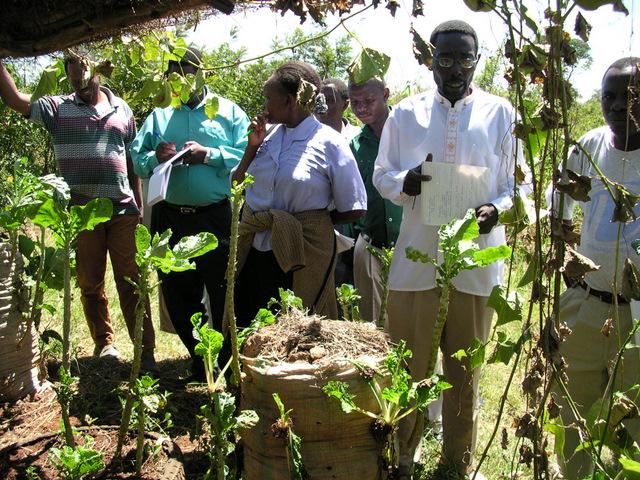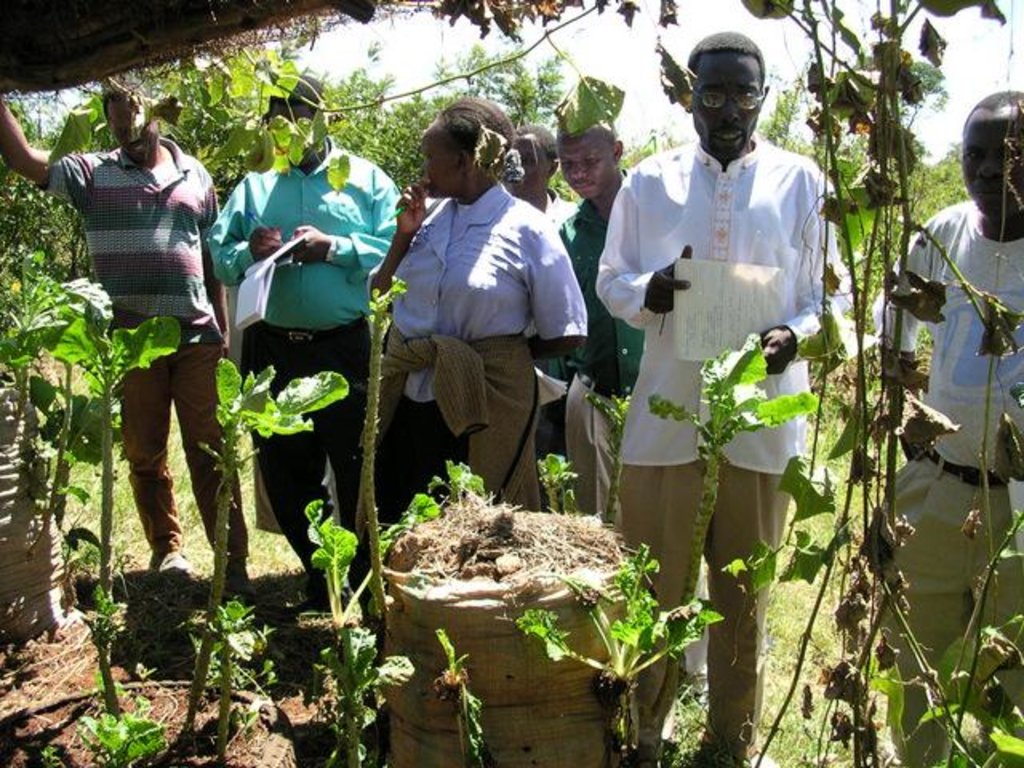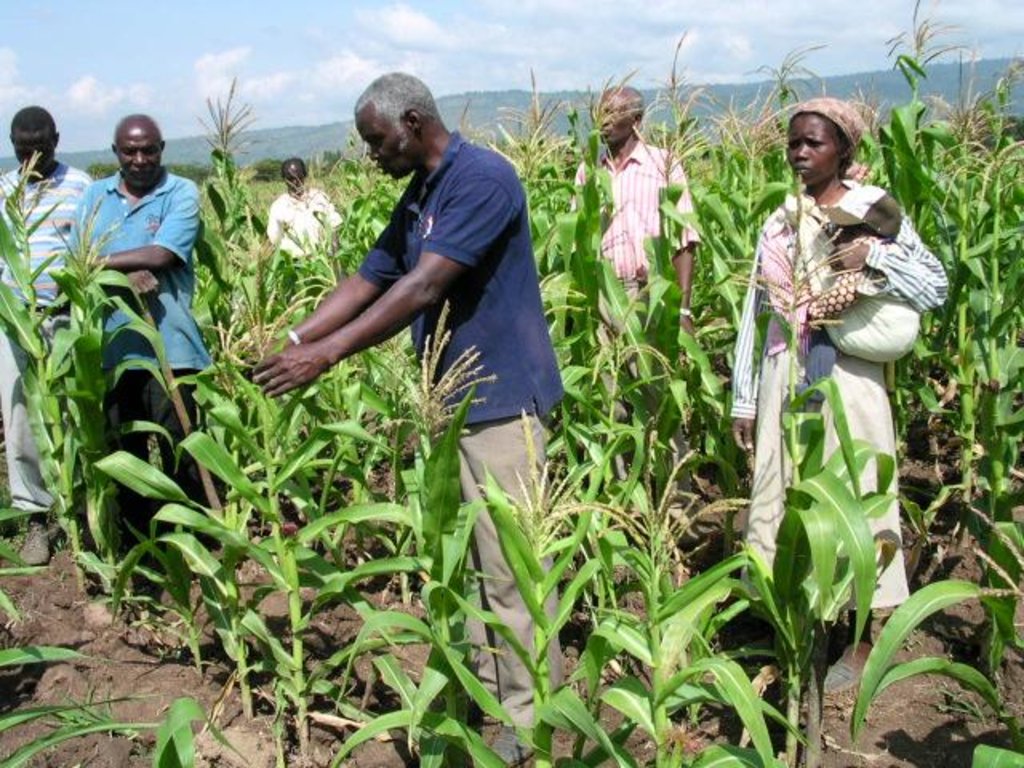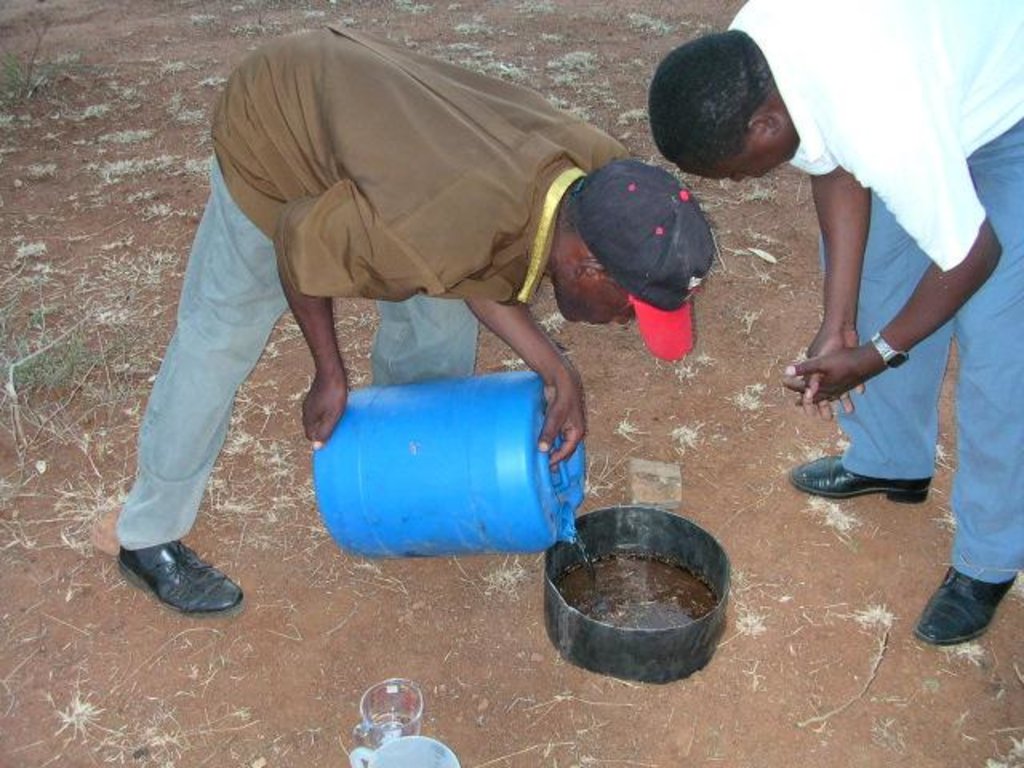Farmer Field Schools [เคนยา]
- ผู้สร้างสรรค์:
- การอัพเดท:
- ผู้รวบรวม: Philippe Zahner
- ผู้เรียบเรียง: –
- ผู้ตรวจสอบ: Fabian Ottiger
approaches_2569 - เคนยา
ดูส่วนย่อย
ขยายทั้งหมด ย่อทั้งหมด1. ข้อมูลทั่วไป
1.2 รายละเอียดที่ติดต่อได้ของผู้รวบรวมและองค์กรที่เกี่ยวข้องในการประเมินและการจัดเตรียมทำเอกสารของแนวทาง
ผู้เชี่ยวชาญ SLM:
Duveskog Deborah
deborah.duveskog@gmail.com
FAO
เคนยา
ผู้เชี่ยวชาญ SLM:
ชื่อของโครงการซึ่งอำนวยความสะดวกในการทำเอกสารหรือการประเมินแนวทาง (ถ้าเกี่ยวข้อง)
Food and Agriculture Organization of the United Nations (FAO) - อิตาลีชื่อของโครงการซึ่งอำนวยความสะดวกในการทำเอกสารหรือการประเมินแนวทาง (ถ้าเกี่ยวข้อง)
Swiss Agency for Development and Cooperation (DEZA / COSUDE / DDC / SDC) - สวิตเซอร์แลนด์1.3 เงื่อนไขที่เกี่ยวข้องกับการใช้ข้อมูลที่ได้บันทึกไว้ผ่านทาง WOCAT
ผู้รวบรวมและวิทยากรหลักยอมรับเงื่อนไขเกี่ยวกับการใช้ข้อมูลที่ถูกบันทึกผ่านทาง WOCAT:
ใช่
1.4 การอ้างอิงถึงแบบสอบถามเรื่องเทคโนโลยี SLM
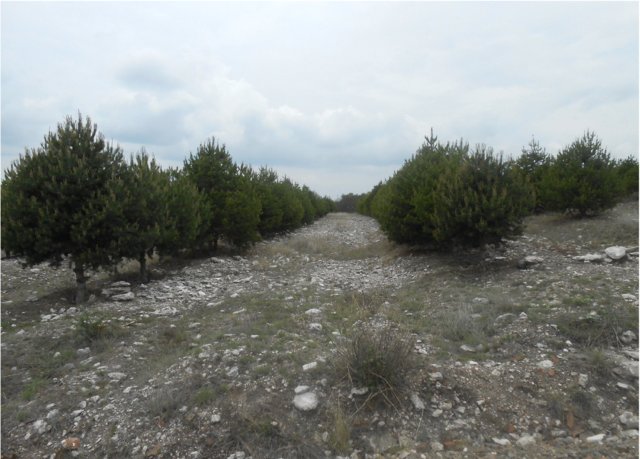
Callejones de piñón con forrajes intercalados [เม็กซิโก]
La tecnología consiste en un sistema agrosilvopastoril con árboles de Pinus cembroides (pino piñonero) alineados een bordos ─en un terreno con suelos calizos previamente subsoleado─ conformando melgas (callejones) para con cultivos anuales para grano y forraje, con pastoreo libre eventual por períodos muy breves.
- ผู้รวบรวม: BENJAMIN SANCHEZ BERNAL
2. คำอธิบายของแนวทาง SLM
2.1 การอธิบายแบบสั้น ๆ ของแนวทาง
A Farmer Field School (FFS) is a community-based practically-oriented field study programme.
2.2 การอธิบายอย่างละเอียดของแนวทาง
การอธิบายอย่างละเอียดของแนวทาง:
Aims / objectives: It is usually a time-bound activity (generally one agricultural production cycle), involving a group (commonly 20-30) of farmers, facilitated by agricultural advisors or – increasingly – by other farmers. The FFS provides an opportunity for farmers to learn together, using practical, hands-on methods of discovery-based and participatory learning.
Methods: The methods emphasise observation, discussion, analysis, collective decision-making, presentation and taking appropriate action. Discussion and analysis are important ways to combine local indigenous knowledge with new concepts and bring both into decision-making. The aim is to develop participants’ decision-making and problem solving capacity among farmers. The process builds self-confidence (particularly for women), encourages group control of the process, and builds management and leadership skills. Although FFS are time-bound, many groups formalise their relations and continue study or action projects, including FFS on other subjects, after the FFS learning cycle is completed. The Farmer Field Schools on Integrated Land and Water Management (ILWM) in eastern and central Kenya focus on learning about how to improve management of land and water resources both on individual plot and farm level and within ‘landscapes’ and communal lands; including local watersheds, river-valleys, forested hill-tops, grazing lands, eroded gullies etc. Each FFS group experiments practically on selected SLM practices/ measures. All learning takes place in the field and farmers usually meet once per week at a selected host farm in their locality to monitor their field experiments and to discuss emerging issues. Trained facilitators, usually agricultural advisors, guide farmers in their observation and analysis of what is taking place in the field. Local farmer innovations are identified to feed indigenous knowledge into the FFS process: Innovators visit FFS groups or FFS members visit innovators farms to share their knowledge.
Other important information: The FFS process combined with the promotion of farmer innovation has proven to contribute to strong and cohesive groups that are able to make informed decisions and change cultural and practical behaviour in order to improve their production and land management. The process also builds self-confidence, and empowers especially women to take on leadership roles in the community. The impacts observed of FFS thus have strong biophysical and social dimensions.
2.3 รูปภาพของแนวทาง
2.5 ประเทศ ภูมิภาค หรือสถานที่ตั้งที่ได้นำแนวทางไปใช้
ประเทศ:
เคนยา
ภูมิภาค/รัฐ/จังหวัด: :
Eastern and Central Kenya
ข้อมูลเฉพาะเพิ่มเติมของสถานที่ตั้ง:
Mwingi, Kitui and Nakuru Districts
Map
×2.7 ประเภทของแนวทาง
- ใช้โครงงานหรือแผนงานเป็นฐาน
2.8 เป้าหมายหรือวัตถุประสงค์หลักของแนวทาง
The Approach focused mainly on SLM with other activities (community organisational building for collective action and collective storage and marketing of products)
Support farmers’ knowledge levels and decision making capacity in relation to sustainable land and water management Raise farmers’ yields in a sustainable manner and ultimately contribute to increased net farm income Strengthen community organisation and collective efforts
The SLM Approach addressed the following problems: Land degradation, climatic variability and loss of agricultural biodiversity, Farmers focus on their own farms and income and lack of interest for wider watershed / environment
3. การมีส่วนร่วมและบทบาทของผู้มีส่วนได้ส่วนเสียที่เกี่ยวข้อง
3.1 ผู้มีส่วนได้ส่วนเสียที่เกี่ยวข้องในแนวทางนี้และบทบาท
- ผู้ใช้ที่ดินระดับท้องถิ่นหรือชุมชนระดับท้องถิ่น
- ผู้เชี่ยวชาญ SLM หรือที่ปรึกษาการเกษตร
- รัฐบาลแห่งชาติ (ผู้วางแผน ผู้ทำการตัดสินใจ)
Ministry of Agriculture
- องค์การระหว่างประเทศ
FAO
3.2 การเกี่ยวข้องของผู้ใช้ที่ดินระดับท้องถิ่นหรือชุมชนระดับท้องถิ่นในช่วงต่างๆของแนวทาง
| ความเกี่ยวข้องของผู้ใช้ที่ดินระดับท้องถิ่นหรือชุมชนระดับท้องถิ่น | ระบุผู้ที่มีส่วนเกี่ยวข้องและอธิบายกิจกรรม | |
|---|---|---|
| การริเริ่มหรือการจูงใจ | ปฏิสัมพันธ์ | |
| การวางแผน | ปฏิสัมพันธ์ | |
| การดำเนินการ | ปฏิสัมพันธ์ | |
| การติดตามตรวจสอบหรือการประเมินผล | ไม่มี | |
| Research | ไม่มี |
3.4 การตัดสินใจเลือกใช้เทคโนโลยี SLM
ระบุผู้ที่ทำการตัดสินใจเลือกเทคโนโลยีมากกว่าหนึ่งวิธีไปปฏิบัติใช้:
- ผู้ใช้ที่ดินเป็นผู้ตัดสินใจหลัก โดยการสนับสนุนจากผู้เชี่ยวชาญ SLM
การอธิบาย:
Decisions on the method of implementing the SLM Technology were made by mainly by land users supported by SLM specialists
4. การสนับสนุนด้านเทคนิค การสร้างขีดความสามารถ และการจัดการด้านความรู้
4.1 การสร้างขีดความสามารถ / การอบรม
ได้มีการจัดอบรมให้แก่ผู้ใช้ที่ดินหรือผู้มีส่วนได้ส่วนเสียคนอื่น ๆ หรือไม่:
ใช่
ให้ระบุว่าใครเป็นผู้ได้รับการอบรม:
- ผู้ใช้ที่ดิน
- เจ้าหน้าที่ภาคสนาม / ที่ปรึกษา
รูปแบบการอบรม:
- เกษตรกรกับเกษตรกร
- จัดคอร์ส
หัวข้อที่พูด:
Agricultural advisors were trained in the FFS approach and in ILWM topics through a total of four weeks of training. Farmers were trained in FFS through season-long FFS learning where farmers meet at a host-farm weekly to carry study activities.
4.2 การบริการให้คำแนะนำ
ผู้ใช้ที่ดินมีการเข้าถึงการรับบริการให้คำปรึกษาหรือไม่:
ใช่
ระบุว่ามีบริการให้คำปรึกษาหรือไม่:
- ไปเยี่ยมชมสถานที่
การอธิบาย/แสดงความคิดเห็น:
Name of method used for advisory service: Participatory extension; Participatory extension with season-long regular interaction between farmers and agricultural advisors. At a later stage also strong farmer-to-farmer extension
The approach requires an attitude shift among agricultural extension workers to become more client-orientated.
4.5 การวิจัย
การวิจัยเป็นส่วนหนึ่งของแนวทางหรือไม่:
ใช่
5. การสนับสนุนด้านการเงินและวัสดุอุปกรณ์
5.1 ระบุงบประมาณประจำปีสำหรับแนวทาง SLM นี้
ถ้าหากว่างบประมาณประจำปีไม่เป็นที่ทราบแน่นอน ให้ระบุช่วงลงไป:
- 10,000-100,000
แสดงความคิดเห็น (แหล่งของการระดมทุน ผู้บริจาคคนสำคัญ):
Approach costs were met by the following donors: international: 60.0%; government: 20.0%; local community / land user(s): 20.0%
5.3 เงินสนับสนุนสำหรับปัจจัยนำเข้า (รวมถึงแรงงาน)
ถ้าแรงงานโดยผู้ใช้ที่ดินเป็นปัจจัยนำเข้าที่มีอยู่มากมาย ระบุด้วยว่าเนื่องจาก:
- สมัครใจ
5.4 เครดิต
มีการจัดหาเครดิตมาให้ภายใต้แนวทาง SLM หรือไม่:
ไม่ใช่
6. การวิเคราะห์ผลกระทบและการสรุป
6.1 ผลกระทบของแนวทาง
ช่วยให้ผู้ใช้ที่ดินนำเอาเทคโนโลยี SLMไปใช้และบำรุงรักษาสภาพไว้ได้หรือไม่:
- ไม่ใช่
- ใช่ เล็กน้อย
- ใช่ ปานกลาง
- ใช่ อย่างมาก
yield increase of more than 200% has been recorded frequently
Did other land users / projects adopt the Approach?
- ไม่ใช่
- ใช่ เล็กน้อย
- ใช่ ปานกลาง
- ใช่ อย่างมาก
the applied practices have spread from participants to neighbours in the community
Did the Approach lead to improved livelihoods / human well-being?
- ไม่ใช่
- ใช่ เล็กน้อย
- ใช่ ปานกลาง
- ใช่ อย่างมาก
improved gender relations and division of farm workload, resistance to drought and improved livelihoods and life satisfaction in general
Did the Approach help to alleviate poverty?
- ไม่ใช่
- ใช่ เล็กน้อย
- ใช่ ปานกลาง
- ใช่ อย่างมาก
all participants fall in the poor or medium poor category and therefore the project has contributed to reduced poverty levels
6.2 แรงจูงใจหลักของผู้ใช้ที่ดินเพื่อที่จะนำ SLM ไปปฏิบัติใช้
- การผลิตที่เพิ่มขึ้น
- กำไร (ความสามารถ) อัตราส่วนค่าใช้จ่ายต่อผลประโยชน์ที่เพิ่มขึ้น
- เกียรติภูมิ แรงกดดันทางสังคม ความเชื่อมแน่นทางสังคม
- การเข้าร่วมสมทบในขบวนการ โครงการ กลุ่ม เครือข่าย
- friendship and collective spirit among group membe
6.3 ความยั่งยืนของกิจกรรมของแนวทาง
ผู้ใช้ที่ดินสามารถทำให้สิ่งต่างๆ ที่ได้ปฏิบัติใช้โดยแนวทางนี้ยั่งยืนได้หรือไม่ (โดยไม่มีการสนับสนุนจากภายนอก):
- ใช่
ถ้าตอบว่าใช่ ให้อธิบายว่าอย่างไร :
Graduated FFS groups have organised themselves into a network and farmer organisations that have taken on collective activities following the end of the initial project. In some cases this has included starting up self-financed new FFS groups.
6.4 จุดแข็งและข้อได้เปรียบของแนวทาง
| จุดแข็ง / ข้อได้เปรียบของแนวทางในทัศนคติของผู้รวบรวมหรือวิทยากรหลัก |
|---|
| The collective action created in communities to deal with and manage their own resources. |
| Improved capacity of farmers for problem solving and innovation in ISWM. |
6.5 จุดอ่อน / ข้อเสียเปรียบของแนวทางและวิธีในการแก้ไข
| จุดอ่อน / ข้อเสียเปรียบในทัศนคติของผู้รวบรวมหรือวิทยากรหลัก | สามารถแก้ไขปัญหาได้อย่างไร |
|---|---|
| A top-down and patronising attitude towards farmers are common among agricultural staff and experts, which prevents equal and trustful relationships | Institutionalisation of participatory extension is thus needed with a change in mindset among government and other agricultural support staff. |
| The various government bodies and ministries responsible for land and water issue often operate individually without strong synergie | A stronger collaboration is needed between ministries especially Ministry of Water and Ministry of Agriculture in order to deal effectively with land and water aspects in an integrated manner. |
7. การอ้างอิงและการเชื่อมต่อ
7.1 วิธีการหรือแหล่งข้อมูล
- ไปเยี่ยมชมภาคสนาม การสำรวจพื้นที่ภาคสนาม
- การสัมภาษณ์กับผู้ใช้ที่ดิน
7.2 การอ้างอิงถึงสิ่งตีพิมพ์
ชื่อเรื่อง ผู้เขียน ปี ISBN:
Duveskog D. 2001. Adapted from A Study Guide for Farmer Field Schools: Water Harvesting and Soil Moisture Retention.FAO-IIRR. 2006. Discovery-based Learning on Land and Water Management: Practical Guide for Farmer Field Schools.
ลิงก์และโมดูล
ขยายทั้งหมด ย่อทั้งหมดลิงก์

Callejones de piñón con forrajes intercalados [เม็กซิโก]
La tecnología consiste en un sistema agrosilvopastoril con árboles de Pinus cembroides (pino piñonero) alineados een bordos ─en un terreno con suelos calizos previamente subsoleado─ conformando melgas (callejones) para con cultivos anuales para grano y forraje, con pastoreo libre eventual por períodos muy breves.
- ผู้รวบรวม: BENJAMIN SANCHEZ BERNAL
โมดูล
ไม่มีโมดูล


